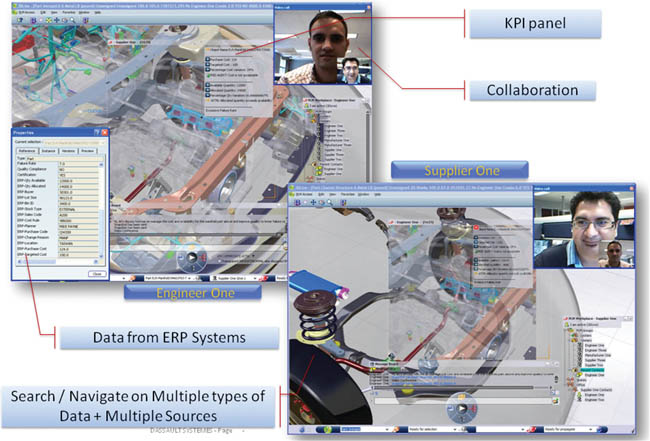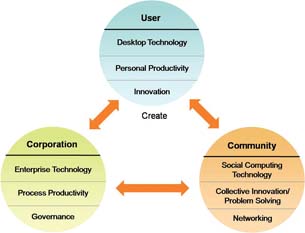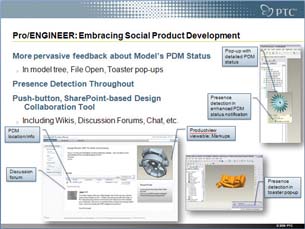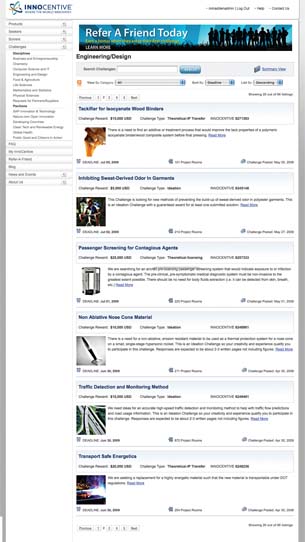ProductPoint, ENOVIA, InnoCentive Form Virtual Think Tanks
Companies are casting their nets further in the ideas market to collaborate on innovation by leveraging social networks
Latest News
November 1, 2009
By Tom Kevan
Innovation is the introduction of something new—an idea, a method or approach, a suite of technologies. And modern engineering, specifically product design and development, rises or falls based on its presence. Economic realities are driving the design community to rethink how it achieves innovation. No longer is it the product of one engineer’s genius or the skill of a company’s engineering team. Increasingly, the ideas of customers, suppliers, and outside experts are being tapped to create broader development networks. To enable the communication and collaboration needed by these networks, companies and technology providers are adapting social networking paradigms to the product design arena.
 Dassault Systèmes’ 3DLIVE enables users to attach data from multiple systems to a 3D Object. If an engineer wants to discuss an issue regarding a part with a supplier, the engineer sees the supplier online and initiates a chat through the Buddy List functionality. The two have the same view and share notes, section cuts, and dimensions in real time. Image courtesy DS |
“The major revolution with social networking is that innovation doesn’t have to come from within a company,” says Marc Halpern, research director for the Gartner Group. “Innovation can come from outside a company. So a manufacturer reaches out to those in the world that have the best expertise and knowledge. Via social networking, you get to the right people quickly.”
 Social product development software consists of three types of applications. Individual user authoring programs; corporate software for control of the design process via PLM, PDM, and configuration management; and community software for real-time ad hoc collaboration required to improve interactionwithin the design community. Image courtesy of PTC |
Adaptation
Social product development is the result of a circuitous evolution of the social networking trend that first appeared in the commercial sector, where online communities of people who share interests and activities are created. In these Web-based communities, participants interact using a variety of social computing technologies, such as e-mail, instant messaging, blogs, wikis, and online forums.
With the evolution of social computing tools, product lifecycle management (PLM) technology providers have begun to see that the functionality of the tools can greatly enhance the design process. The vendors realize that they can provide better ways for the stakeholders to communicate and work together. But there are too many risks associated with using commercial tools such as FaceBook, Twitter, and LinkedIn, where a company’s intellectual property can be accessed by anyone, including competitors.
In its paper, “Social Computing in the Enterprise,” Microsoft offers a vision of companies balancing the “benefits of knowledge sharing and relationships with sound IT and business principles.” Along these lines, technology providers have begun adapting social product development tools for an enterprise framework by including more security and control. Access and participation are becoming context driven, with the functionality defining the roles people play, the programs they have access to, and the tasks they perform.
The collaboration and communication features and benefits of social networking and social computing are now gaining traction in the product-development arena. Engineers and managers can now search and access shared files. They have the ability to work together, view relevant data and design visuals in common workspaces, and discuss design issues in joint work sessions.
“We’ve always talked about doing collaboration,” says Kenneth Amann of CIMdata. “Now we are beginning to see people use more direct-interaction capabilities…. If we really want to get everybody involved, we want to find the people who are pertinent to the work, to interact with them directly. It becomes more of a social interaction.”
Forces of Change
It’s one thing to understand how a new technology has evolved, but it is quite another to see what market forces are driving its development and why you should use it. In the case of social product development, no one element is pushing the technology’s growth and adoption. Many factors are involved, but at the top of the list are two economic realities.
 PTC’s integrated suite of PLM products, which includes Pro/ENGINEER, derives its social computing functionality from Microsoft Share- Point technology. The features include instant messaging, presence detection, and status notification, as well as the ability tocreate blogs and wikis. Image courtesy of PTC |
The product development process has become more global in nature, and the broad distribution of design teams is a fact of life. “The global nature of product development is forcing companies to find ways to get high-level performance over wide-area networks,” says Chad Jackson, research director for the Aberdeen Group.
In addition, increased competition is forcing companies to strive for shorter product-development cycles. “We consistently see that shortened development cycles are the top pressure that engineers are facing,” says Michelle Boucher, research analyst for Aberdeen Group. “They are constantly trying to be faster, work more efficiently, and be able to interact and collaborate more easily, which lends itself very nicely to Web 2.0 technology.”
Another factor driving social product development is the rising influence of the mechatronic design approach. “Electrical engineers, mechanical engineers, and embedded systems engineers have different design and validation processes, yet they need to be able to integrate them,” says Jackson. “So communication and collaboration is at a premium. You can actually use social media, or Web 2.0 technologies, to document design decisions centrally and collaborate around what decision to make ]among] those different stakeholders.”
Says Boucher, “In the last study we did on mechatronic system design in January 2008, the top challenge is overcoming the silos of knowledge of the engineering disciplines and breaking those communication barriers. Finding different ways to communicate would definitely be a way to solve that.”
Demographics are also coming into play. “The younger generation of engineers moving into the workforce has grown up on these social networking tools,” says Robin Saitz, senior VP of communications for PTC. “They will expect, and potentially even demand, these types of applications in their work environment because that is what they know.”
Finally, the pressure for design innovation is moving social product development forward. “We did a case study on Procter & Gamble,” says Gartner’s Halpern. “Through this type of social network, the claim was made that Procter & Gamble was trying to get 50 percent of its innovation from the outside so that they don’t suffer from the ‘not invented here’ type of blindness. The claim was made that by using this type of technique that Procter & Gamble’s 7,500 engineers were able to leverage input from more than 50,000 people on the outside, on a global basis, to stimulate greater innovation.”
 InnoCentive’s Disciplines pages list all challenges related to a particular field. On the Engineering/Design page, users get a brief description of each, awards, posting dates, and deadlines. They can also see how manypeople have responded to the challenge. Image courtesy of InnoCentive |
The Strength of Weak Ties
If you step back and look at the big picture, two types of applications have provided the backbone of product development functionality: authoring software, for CAD and source code development, and enterprise control software, for PLM, PDM, and configuration management. One element that’s been missing is software technology that enables the real-time ad hoc collaboration required to improve interaction within the design community; the core of social product development. These applications enable design communities to find and capture information, connect with people, and leverage networks to solve problems.
Social product development networks are made up of a number of communities both inside and outside the enterprise. “Each organization has a number of communities of innovation,” says David Ritter, CTO of InnoCentive. “Each of these communities has different characteristics, wants, and needs, and they can contribute to the innovation processes in a particular way. These can include enterprise employees, customers, and the rest of the world. There’s lots of latent knowledge and solutions … coming from places that seem quite unlikely.”
“The real benefit of social networking is the strength of weak ties,” says PTC’s Saitz. “It is leveraging the people you know to get to people you don’t know who can help you.”
Pioneers
For a glimpse of the impact that social product development will have on the design process and how it has begun to be integrated into PLM tools and services, let’s take a look at three products. It’s important to understand that these products are the starting point as the full potential of the technologies has yet to be realized.
PTC offers Windchill ProductPoint to enable designers to manage collaboration on structured data and ProductView for viewing, marking up, and measuring 3D geometry by non-CAD users to be integrated with its Pro/ENGINEER MCAD solution. By building ProductPoint natively on top of Microsoft’s SharePoint platform, PTC makes a variety of social product development functionality available throughout its entire PLM suite. The features include instant messaging, presence detection, and status notification, as well as the ability to create blogs, wikis, and MySite pages for products and subassemblies. Essentially, PTC has taken general social computing tools and tailored them for product development teams.
Typically designers don’t have a good way to capture design intent—to describe for other team members what they are thinking and what the problems are. PTC’s technology enables them to use a wiki in ProductPoint to be exposed within Pro/ENGINEER. Members of the design team can edit the model notes in the wiki to express what they are thinking and the notes can be viewed and edited through a browser.
In another approach, InnoCentive.com provides a program that connects companies, academic institutions, public, and nonprofit organizations with a global network of more than 160,000 of the world’s brightest minds. Enterprises, primarily Fortune 500 companies, with design problems (called Seekers) post challenges on the company’s website. Each challenge has a bounty, or cash prize, associated with it, which ranges from $5,000 to $1 million. People registered with InnoCentive (called Solvers) post solutions to the problems. The Seekers evaluate the submissions and decide whether they meet their criteria for success. If they find a solution that meets their requirements, they pay the award, and the intellectual property is transfered from the Solver to the Seeker. Other companies with similar services include YourEncore, Yet2.com, and NineSigma.
“It is the diversity of the community that looks at these problems that matters most in ensuring that they get solved,” says InnoCentive’s Ritter, explaining that it is the social aspect of product development that makes it possible to find the one person in the world uniquely qualified to answer the specific question.
While it does not offer InnoCentive’s potential numbers of untapped imaginations, Dassault Systèmes’ ENOVIA emphasizes the importance of a shared workspace and 3D modeling in social product development. “We think the presence of 3D makes a real difference in PLM, and one of the things that differentiates collaboration from communication is the shared workspace,” says John Squire, a VP for ENOVIA.
For example, in 3DLIVE’s shared workspace, you can physically navigate through multiple levels of detail of a product’s 3D model. By clicking on a part, you can view all relevant metadata, including the name and email address of the primary designer, the part’s development stage, the original requirements, and the NC machining instructions. Each workspace also has a special window that allows multiple people to collaborate online, using instant messaging or video conferencing, with participation and viewing privileges defined by security clearances. Not limited to any single product, these features are integral to ENOVIA’s core architecture whether in 3DLIVE or CATIA V6.
Dassault recently announced a partnership with the European social networking company blueKiwi, and is expected to feature blogs, posts, wikis, and user profiles in upcoming software offerings.
As the world of social networking develops, it will be interesting to see how it aids the rapidly shrinking world of engineers and designers. It will almost certainly increase the pace at which we innovate and collaborate.
More Info:
Aberdeen Group
Tom Kevan is a New Hampshire-based freelance writer specializing in technology. Send your comments about this article to [email protected].
Subscribe to our FREE magazine, FREE email newsletters or both!
Latest News
About the Author
DE’s editors contribute news and new product announcements to Digital Engineering.
Press releases may be sent to them via [email protected].






